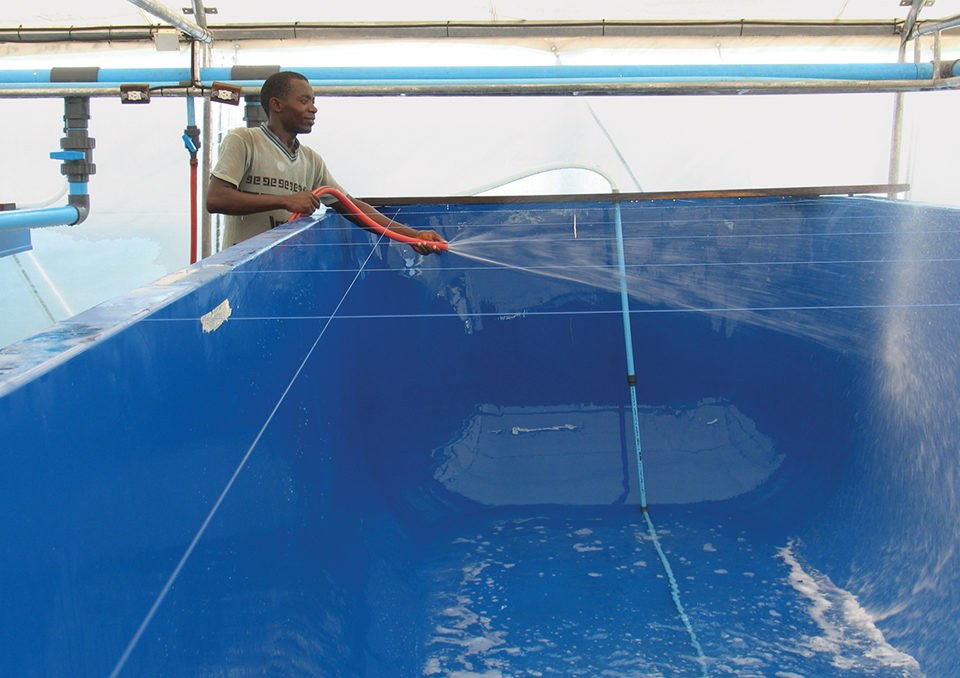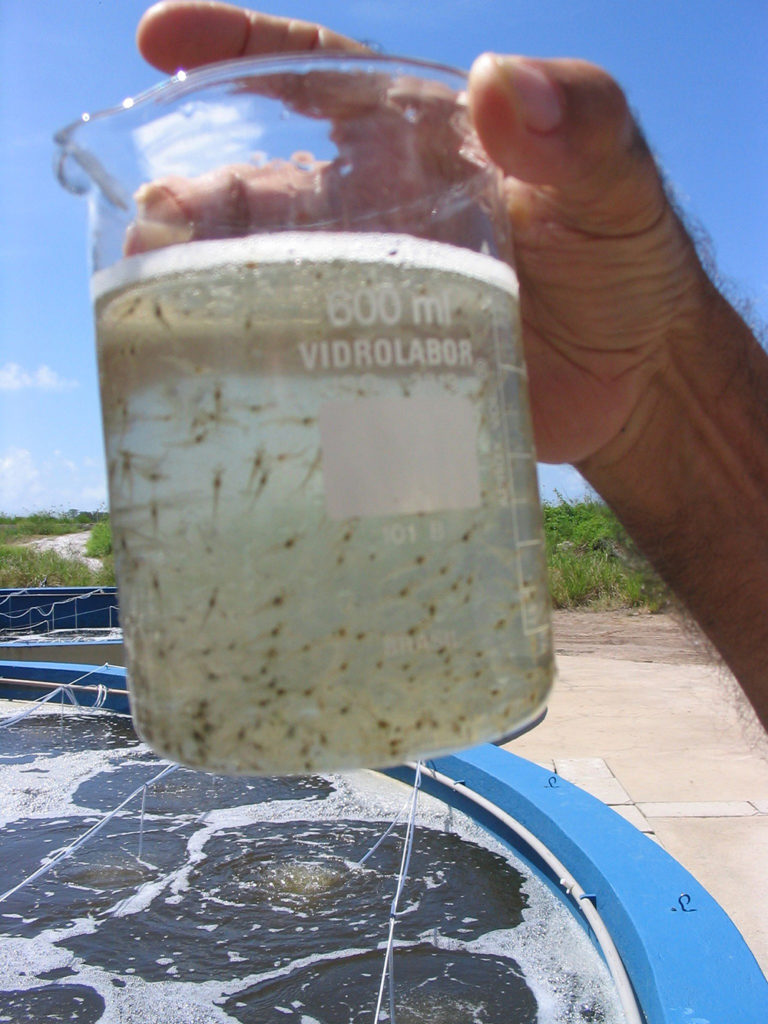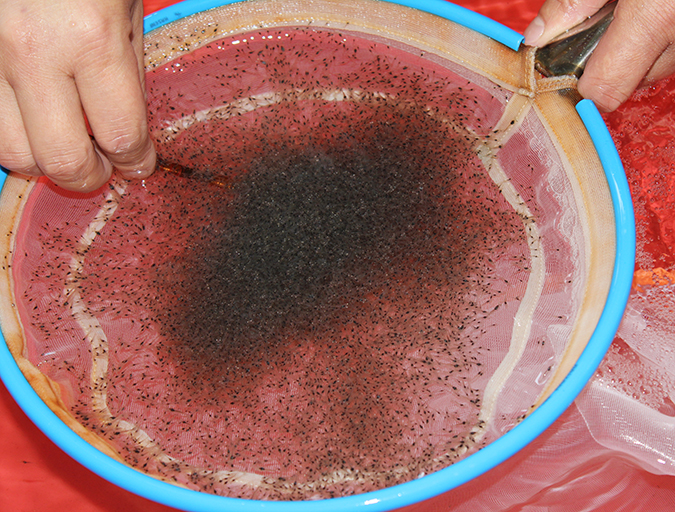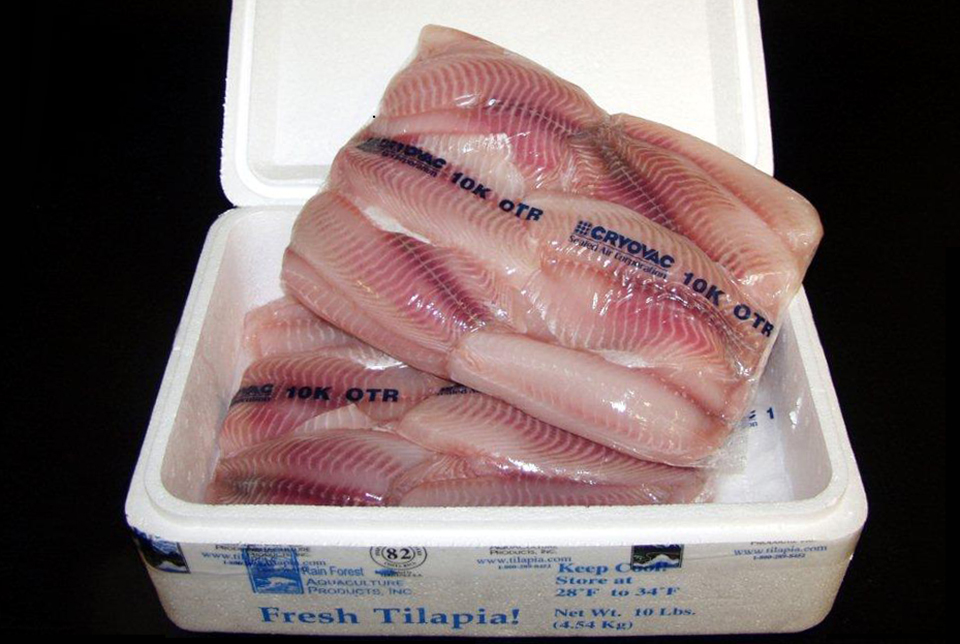Chlorine compounds can be toxic to culture species and workers

Chlorination is practiced widely in aquaculture for disinfection of holding and rearing tanks for fish. Chlorine compounds are applied to puddles of water in the bottoms of empty ponds to eliminate wild fish before refilling ponds. Chlorination also has been used to kill disease organisms or their vectors in water supplied to hatcheries and in shrimp ponds before stocking.
Chlorine compounds can be toxic to culture species, but they also can be toxic to workers. Those adopting chlorination as a management practice should have knowledge of the behavior of chlorine compounds in order to use them effectively and safely.
Chlorine sources
The three common sources of chlorine are chlorine gas, sodium hypochlorite or household bleach, and calcium hypochlorite, commonly called high-test hypochlorite or HTH.
Chlorine gas often is used for disinfection of municipal water supplies. It is delivered in railroad tank cars or tank trucks, or generated on site. However, the chlorine is highly toxic to humans and was used in World War I against troops. Chlorine gas is therefore not safe for use at aquaculture facilities.
Sodium hypochlorite is a dilute, liquid solution, but because of its low percentage of active ingredient, it is not widely used in aquaculture. A granular material containing about 65 percent active ingredient, calcium hypochlorite is preferred for aquacultural purposes.
Reactions in water
The active ingredients in chlorination products are chlorine gas, hypochlorous acid (HOCl) and hydochlorite ions (OCl-) that result from the dissociation of HOCl. These forms are called free chlorine residuals. In terms of disinfecting power, chlorine gas and HOCl are about 100 times more potent than OCl-.
When a chlorination product is applied to water, it dissolves and chlorine speciation occurs based on pH. At pH below 2, chlorine gas is dominant. Between pH 2 and 6, HOCl is the only type. As pH increases beyond 6, OCl- appears. At a pH of about 7.5, HOCl and OCl- occur in equal proportions, but at higher pH, OCl- is the most abundant chlorine.
Application rates for chlorination products should be increased as pH rises. For high pH values, the dose rates for achieving 1 mg/l of free chlorine residual using HTH with 65 percent active ingredient are as follows: pH 7.0, 1.54 mg/l; pH 7.5, 2.34 mg/l; pH 8.0, 4.71 mg/l; pH 8.5, 11.80 mg/l; pH 9.0, 29.20 mg/l.
Free chlorine residuals are strong oxidants that oxidize organic matter, nitrite and other reduced substances. Free chlorine residuals are reduced to nontoxic chloride in these reactions, and their disinfecting power is lost.
Chlorine species also react with ammonia to form chloramines that have less disinfecting power than free chlorine residuals. Chloramines are called combined chlorine residuals. Some vendors sell chloramines for use as disinfectants for aquaculture, but these products are not as effective as calcium hypochlorite.
Free chlorine residuals quickly decompose to chloride and water in the presence of light. In outdoor systems, the residual action of chlorination lasts only a few hours, or at most a few days.
Applications
Chlorination usually is applied to provide a free chlorine residual of 1-3 mg/l. The amount of calcium hypochlorite necessary to provide this concentration depends upon pH (Table 1), as discussed above. It also is influenced by the abundance of plankton and bacteria, and the concentrations of dissolved and suspended organic matter, ammonia nitrogen, nitrite and other reduced substances.
Boyd, Effect of pH on hypochlorous acid:hydochlorite ion ratios, Table 1
| pH | Hypochlorous Acid: Hydochlorite | Free Chlorine Residual Needed for Disinfecting Power of 1 mg/l at pH 7 Ion Ratio |
|---|---|---|
| 6.0 | 32.00 | 0.78 |
| 6.5 | 10.00 | 0.84 |
| 7.0 | 3.20 | 1.00 |
| 7.5 | 1.00 | 1.52 |
| 8.0 | 0.30 | 3.06 |
| 8.5 | 0.10 | 7.68 |
| 9.0 | 0.03 | 19.00 |
The best way to determine the required dosage is to measure the chlorine demand. This is the amount of chlorine product necessary to react with living organisms and reduced substances in water. The treatment dose should be equal to the chlorine demand plus enough of the product to provide 1-3 mg/l free chlorine residual.
Since the chlorine demand test is difficult to conduct, most farmers use a dose proven effective previously. In Southeast Asia, shrimp farmers often treat ponds before stocking postlarvae with 20-30 mg/l of calcium hypochlorite. However, products provided by different vendors can vary in strength, and a wide range in concentration of free chlorine residuals probably is applied to ponds.
Chlorine effects
When done correctly, chlorination can kill possible wild vectors of disease in ponds. However, a study conducted at Auburn University revealed that small doses of chlorine added to channel catfish ponds were rendered ineffective immediately by extraneous reactions with organic matter. Chlorination also kills plankton and benthos, leaving little natural food available when postlarvae are stocked. Shrimp ponds should be fertilized a few days after chlorination to encourage the regrowth of natural food organisms before introducing postlarvae.
Chlorine solutions sprayed over the bottoms of empty ponds during pond preparation are not likely to be highly effective in eliminating disease organisms harbored in the soil from the previous crop. Soil contains a large amount of organic matter relative to water, and treatment of moist soil with up to 500 mg/kg active chlorine from high-test hypochlorite did not reduce microbial abundance in a research trial. Treatment of the pond water usually is more effective.
Some farmers think that chlorination of water or bottom soil reduces organic matter concentrations. Although chlorine does oxidize organic matter, at the concentrations used in aquaculture, it only reacts with highly reactive functional groups on organic molecules and does not cause a significant reduction in organic matter concentrations in water or bottom soil.
Chlorinated water from municipal water supplies often is used to fill tanks or aquariums for holding aquatic organisms. Although this water initially may have sufficient residual chlorine to severely stress or kill aquatic animals, it can be held a few days until the chlorine residuals have dissipated through exposure to light and extraneous reactions.
Alternatively, the chlorine can be removed immediately by application of sodium thiosulfate. It requires about 7 mg/l sodium thiosulfate to remove 1 mg/l free residual chlorine. Sodium thiosulfate is not appreciably toxic to fish and other organisms and is often applied according to previous experience.
Safety
Chlorination should be applied cautiously. Chlorine gas is dangerous to use at aquaculture operations because of the possibility of accidental release and subsequent injury or death to workers. Sodium or calcium hypochlorite can generate toxic chlorine gas if put into highly acidic water. Spills of chlorine products into ponds or natural waters can destroy aquatic life. Workers should wear protective clothing and masks with suitable air filters when working with concentrated sources of chlorine.
(Editor’s Note: This article was originally published in the November/December 2008 print edition of the Global Aquaculture Advocate.)
Now that you've reached the end of the article ...
… please consider supporting GSA’s mission to advance responsible seafood practices through education, advocacy and third-party assurances. The Advocate aims to document the evolution of responsible seafood practices and share the expansive knowledge of our vast network of contributors.
By becoming a Global Seafood Alliance member, you’re ensuring that all of the pre-competitive work we do through member benefits, resources and events can continue. Individual membership costs just $50 a year.
Not a GSA member? Join us.
Author
-

Claude E. Boyd, Ph.D.
Department of Fisheries and Allied Aquacultures
Auburn University
Alabama 36849 USA[117,100,101,46,110,114,117,98,117,97,64,49,101,99,100,121,111,98]
Tagged With
Related Posts

Responsibility
A look at various intensive shrimp farming systems in Asia
The impact of diseases led some Asian shrimp farming countries to develop biofloc and recirculation aquaculture system (RAS) production technologies. Treating incoming water for culture operations and wastewater treatment are biosecurity measures for disease prevention and control.

Health & Welfare
A study of Zoea-2 Syndrome in hatcheries in India, part 2
Indian shrimp hatcheries have experienced larval mortality in the zoea-2 stage, with molt deterioration and resulting in heavy mortality. Authors considered biotic and abiotic factors. Part 2 describes results of their study.

Health & Welfare
Acclimating shrimp postlarvae before pond stocking
Shrimp postlarvae acclimation before stocking into the various growout systems (ponds, raceways, tanks) is a critical – and often overlooked, sometimes taken for granted – step in the shrimp culture process. Various water quality parameters should be changed slowly so that the young shrimp have the time to gradually adapt to the new conditions.

Intelligence
An examination of seafood packaging
Some substances can migrate from plastics and other seafood packaging materials into the product. Even if the substances are not harmful, they can affect the flavor and acceptability of the food.


